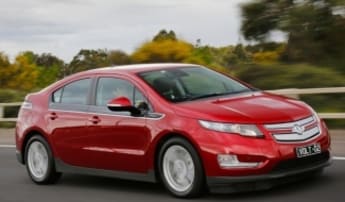Range anxiety isn’t an issue with Holden’s electric-powered Volt. The $59,990 price is, which is why Holden is saying the range-extending hybrid will initially appeal to early adopters.
The four-seat car combines a battery with a theoretical 87km range - in reality it’s somewhere between 50-70km - along with a 1.4-litre four-cylinder engine that generates power for the electric motor, rather than drive the front wheels directly. Fitting the 200kg battery pack has cost the centre rear seat on the Cruze-based platform but other than that it drives - and goes - just like Holden’s most popular car.
Value
The high entry price is one of the handicaps electric vehicles and hybrids are still trying to overcome. New technology isn’t cheap, be it an LED TV or the latest iPhone. Early adopters tend not to care … average families will wait for the price to drop and the tech to prove itself before climbing on board.

In the case of the Volt, an average daily commute of 50km will translate into roughly $1100 in annual fuel savings. The Volt can be charged at home using a regular 6/10amp power supply, in which case the charging times are around 10/six hours. Opt for a fast-charge point from Better Place and that time falls to four hours.
Technology
Beyond the concept, the battery pack is the smart component of the Volt. GM-developed software monitors the 288 lithium-ion modules that make up the pack - which is fitted in a T-shape between the front seats and across the rear pews - and regulates the charge to minimise hot-spots that compromise battery longevity.
The same system heats/cools the battery to keep it at the optimum operating temperature. The 1.4-litre petrol “generator” that powers the electric motor once the battery charge is depleted is a detuned version of the 1.4-litre engine fitted to the Cruze. A smaller capacity engine would have done the job just as well, but for GM it was an off-the-shelf solution that cut costs - and therefore the final price. Cruise control, Bluetooth connectivity, satnav, lane departure warning and a collision alert system are standard.
The collision alert isn’t adaptive cruise control, though. Instead it sounds a warning if the Volt is approaching another vehicle too quickly.
Styling
The Volt is the best-looking hybrid on the road, if you exclude the more exotic Telsa machinery. Optimising drag means the five-door hatch has a rubber front spoiler that will scrape every time its driven over a speed hump or an angled drive. The sound is disconcerting but the fact it tucks up under the car means there’s no visual damage. Inside a white centre stack houses all of the switchgear.
It looks futuristic and functional, though some of the displays on the seven-inch touch screen are eco-trendy rather than geniuinely informative: I don’t need to know how efficient the aircon is; I just want it to work. The seats and steering wheel stalks are straight out of the Cruze. Rear visibility is limited by the thick C-pillars, but a reversing camera offsets that.
Safety
The Volt has earned a five-star ANCAP safety rating, with an overall score of 34.56 out of 37. The safety body notes that “Protection from serious leg injury was marginal for the driver”. There are eight airbags as standard along with the usual software systems. Just as importantly, Holden is educating the emergency services about what and where to cut in the event the Volt is damaged during a crash.
Driving
Despite the weight - the Volt is heavier than a Commodore - it goes and rides reasonably well. Acceleration is a flat nine seconds from rest to 100km/h and it is only the low rolling-resistance rubber that limits its ability in the twisty stuff. The hard compound means the Volt understeers earlier than a Cruze. Fit a set of decent tyres and that won’t be a problem, though it will reduce the electric-only range.
The hatch sits flat through the turns thanks to battery pack being fitted low and in the middle of the vehicle, but fore/aft pitching is noticeable when pressing on over roads with humps and dips. Using petrol to power an electric vehicle seems counter-productive but it makes the Volt a genuine option in a one-car garage.
During the week electric-only driving should be achievable and the petrol generator gives owners the freedom to travel where they want on weekends. Over a 300km drive, Carsguide posted 4.6L/100km despite intentionally vigorous driving. I’d be happy with that - if Holden can get the price down to $40K.
Holden Volt 2012:
| Engine Type | Not Applicable, 0.0L |
|---|---|
| Fuel Type | Unleaded Petrol/Electric |
| Fuel Efficiency | 1.2L/100km (combined) |
| Seating | 5 |
| Price From | $8,910 - $12,540 |
| Safety Rating |
|
Verdict
This is much less of a science project than other EVs on the market, even if it still isn’t affordable for the average family. You’ve got to start somewhere and Holden’s take on future propulsion - at least in the short-term - eliminates the fear of being stranded away from a charge point.
Range and Specs
| Vehicle | Specs | Price* |
|---|---|---|
| Base | Unleaded Petrol/Electric, SPEED CONTINUOUS VARIABLE | $8,910 - $12,540 |





























.jpg)








































.jpg)